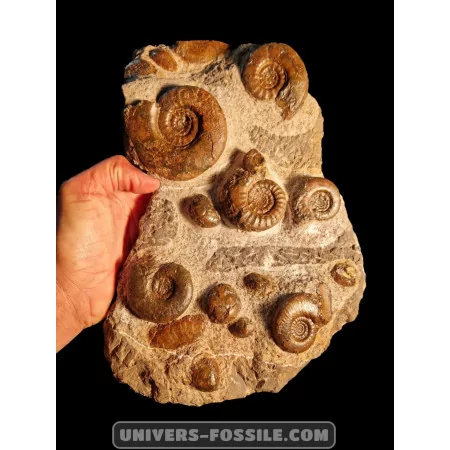Ammonites and bivalves plate
Ammonites and bivalves plate
100% natural
Size: 30x21cm
By buying this product you can collect up to 19 loyalty points . Your cart will contain total 19 points that can be converted into a voucher of €3.80 .
Secure transactions with advanced encryption
Shipped in 1 open day
Easy returns and full refund
Ammonites: Fascinating Fossil Wonders
Ammonites are captivating fossils that have intrigued researchers and paleontology enthusiasts for centuries. These extinct marine creatures belong to the class of cephalopod mollusks and thrived in the oceans worldwide for millions of years.
Ammonites were agile predators equipped with characteristic spiral shells. Their varied shape and complexity have allowed scientists to use them as valuable stratigraphic indicators to date rocks and reconstruct the geological history of the Earth.
Features of Ammonites
Ammonites had external shells composed of mother-of-pearl, similar to those of modern squids and octopuses. Their shell, often richly ornamented, helped protect them from predators and regulate their buoyancy in the water.
A distinctive feature of ammonites is their suture, the intricate suture line marking the junction of chambers in their shell. These sutures varied in complexity and pattern among species and are often used to classify and identify ammonite fossils.
Ammonites in History
Ammonites have played a significant role in many cultures throughout history. Their fossils have been discovered in ancient archaeological sites and have often been interpreted as protective talismans or symbols of luck.
The earliest known references to ammonites date back to antiquity. The Greeks and Romans often regarded them as relics of the gods, while civilizations in the Middle Ages sometimes interpreted them as horns of dragons or petrified serpents.
Diversity of Ammonites
Ammonites thrived for over 300 million years, and over time, they evolved to inhabit a wide diversity of marine environments. Their shell shapes, sizes, and patterns varied considerably, allowing paleontologists to recognize thousands of different species.
From elaborate, giant sea creatures to more modest and understated specimens, ammonites were among the most diverse creatures in the history of life on Earth.
Conclusion
In conclusion, ammonites represent fascinating examples of the richness of prehistoric marine life. Their beauty, diversity, and stratigraphic importance make them valuable subjects of study for scientists and sought-after treasures for fossil collectors worldwide.
Ammonites and bivalves plate - Exquisite Fossils from Ancient Seas
Ammonites and Bivalves Plate - Captivating Fossil CollectibleAmmonites: Fascinating Fossil Wonders Ammonites are captivating fossils that have intri...
Read MoreAmmonites and Bivalves Plate - Exquisite Fossil Decor | Ammonites Category
Ammonites and Bivalves Plate: Exquisite Fossil Art Piece Discover the mesmerizing world of ammonites with our beautifully crafted Ammonites and B...
Read MoreAmmonites and Bivalves Plate - Exquisite Fossil Collection | Ammonites
Ammonites and bivalves plateAmmonites: Fascinating Fossil Wonders Ammonites are captivating fossils that have intrigued researchers and paleonto...
Read MoreAmmonites and Bivalves Plate - Unique Fossil Decor for Fossil Enthusiasts
Ammonites and Bivalves Plate: A Stunning Fossil DisplayPrepare to be mesmerized by the ancient charm of the Ammonites and Bivalves Plate. This exqui...
Read MoreAmmonites and bivalves plate - Explore the Fascinating World of Ammonites
Ammonites and Bivalves PlateAmmonites: Fascinating Fossil Wonders Ammonites are captivating fossils that have intrigued researchers and paleontology...
Read More




